By Finlay Connolly
I’ll be honest with you—when I first came across the Maksiwa table saw, I was skeptical. The woodworking tool market is flooded with brands promising professional results at bargain prices, and most of them end up collecting dust in garages or being sold on Facebook Marketplace within six months. But after spending considerable time researching this particular model and digging into what real users are saying, I’ve developed a more nuanced perspective that I think you’ll find helpful.
Let me walk you through everything you need to know about the Maksiwa table saw in 2025, from its actual capabilities to whether it deserves a spot in your workshop.
What Exactly Is the Maksiwa Table Saw?
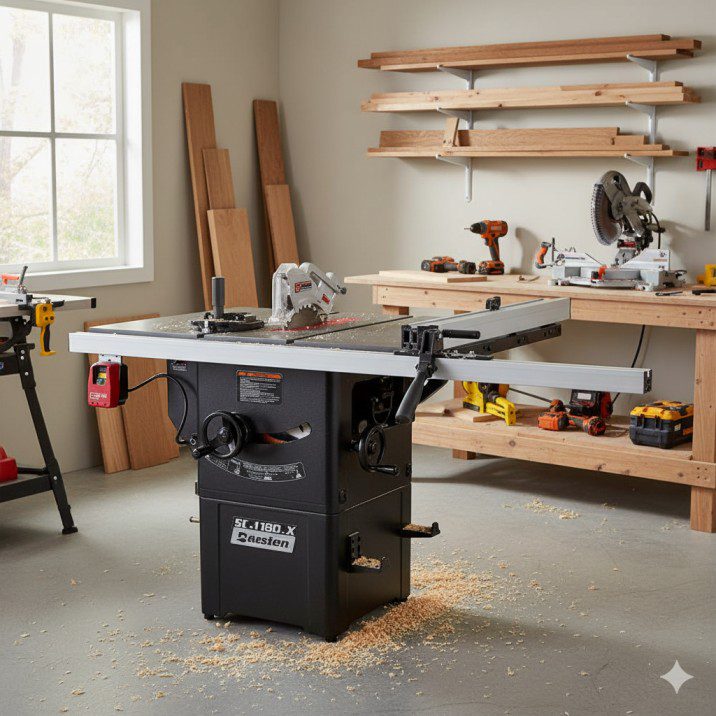
The Maksiwa table saw has been making waves in the budget-conscious woodworking community, particularly among hobbyists and weekend warriors who want decent cutting performance without taking out a second mortgage. It’s positioned as an entry-level to mid-range stationary saw that promises to handle common workshop tasks like ripping lumber, crosscutting boards, and making basic joinery cuts.
Check out our complete Table Saw Reviews Guide for expert insights and unbiased recommendations.
What sets it apart from other budget options isn’t necessarily groundbreaking innovation—it’s the combination of features you’d typically find on more expensive models packed into a price point that won’t make your wallet weep. We’re talking about things like a reasonably powerful motor, adjustable blade height and angle controls, and a fence system that doesn’t wobble like a shopping cart with a bad wheel.
The brand itself has been steadily building its reputation over the past few years, focusing primarily on the DIY and hobbyist market rather than trying to compete with established names like DeWalt, Bosch, or SawStop in the professional contractor space.
Key Specifications and Features That Actually Matter
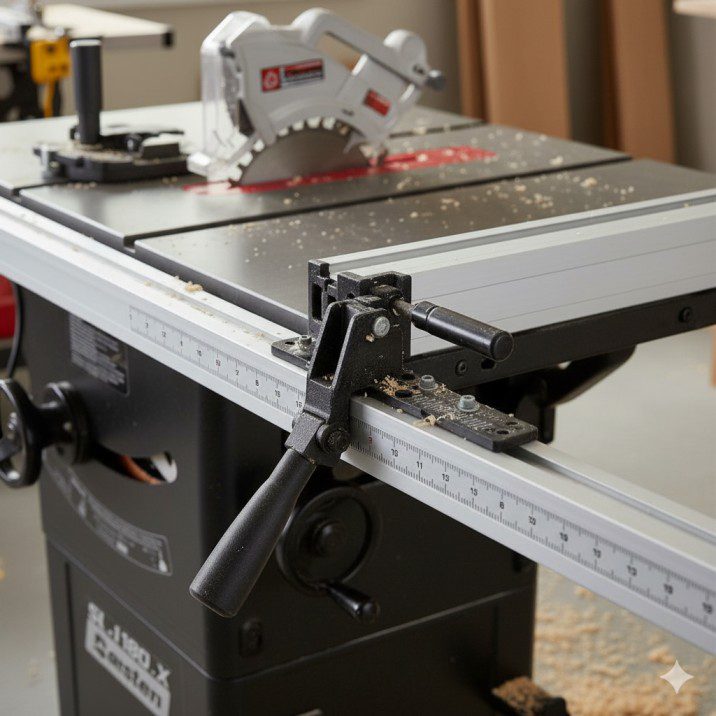
Let’s cut through the marketing jargon and focus on what you really need to know about this saw’s capabilities.
Motor Power and Cutting Capacity
The Maksiwa typically comes equipped with a 15-amp motor that delivers around 4,800 RPM. Now, I know those numbers might not mean much if you’re new to power tools, so here’s the practical translation: this gives you enough oomph to cut through standard dimensional lumber, hardwoods up to about 2 inches thick, and sheet goods like plywood or MDF without the motor bogging down constantly.
The blade height adjustment allows for cuts up to approximately 3.125 inches at 90 degrees, which covers most common woodworking scenarios. When you tilt the blade to 45 degrees for bevel cuts, you’re looking at roughly 2.25 inches of cutting depth. These aren’t jaw-dropping numbers, but they’re perfectly adequate for furniture building, cabinet making, and general project work around the house.
Table Surface and Work Area
One complaint I hear frequently about budget table saws is the small work surface that makes handling larger sheets of plywood feel like a gymnastics routine. The Maksiwa addresses this somewhat with a cast aluminum table top that measures around 26 by 22 inches, depending on the specific model configuration.
The surface itself has a smooth finish that allows stock to glide across without excessive friction. I won’t pretend it’s as refined as the machined cast iron tables on premium saws, but it’s significantly better than the stamped steel surfaces you’ll find on bottom-tier models. The material also keeps the overall weight manageable—important if you’re working in a smaller shop where you might need to move equipment around occasionally.
Fence System: The Make-or-Break Feature
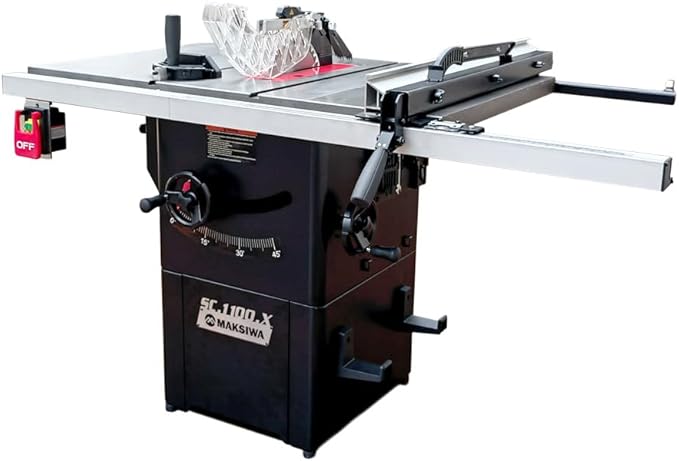
Here’s where many budget saws completely fall apart, and honestly, it’s where the Maksiwa shows both its strengths and limitations. The rip fence uses a rack-and-pinion style adjustment system with measurements marked on both sides of the blade. The fence itself is made from extruded aluminum with a T-square design that’s supposed to stay parallel to the blade.
In practice, most users report that the fence is decent out of the box but benefits significantly from proper setup and calibration. You’ll likely need to spend 30 minutes to an hour squaring everything up when you first assemble the saw. Once dialed in, it holds its position reasonably well for most cuts, though you should still verify measurements on critical cuts rather than blindly trusting the scale.
The fence extends to allow rip cuts up to 24-25 inches to the right of the blade, which handles a full sheet of plywood ripped in half. There’s typically no left-side fence capacity, which is standard for saws in this category.
Setting Up Your Maksiwa: What to Expect on Day One
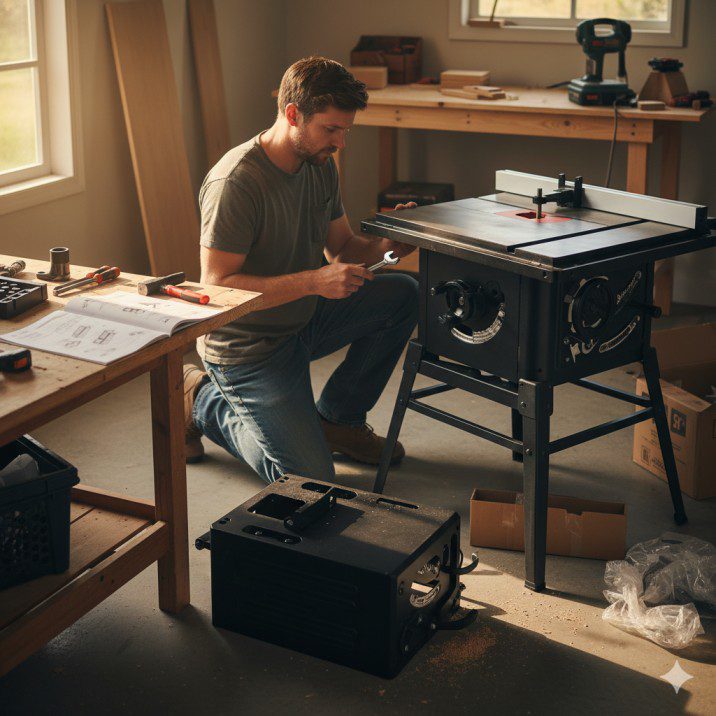
Unboxing and assembling this saw is going to take you anywhere from two to four hours, depending on your mechanical aptitude and whether you’ve put together power tools before. The saw arrives partially assembled, but you’ll need to attach the stand (if included), mount the blade guard, install the rip fence rails, and calibrate the blade alignment.
Here’s something most reviews won’t tell you: budget your time for proper setup. The temptation is strong to rush through assembly so you can start cutting, but spending quality time squaring the fence, checking blade alignment with a reliable square, and ensuring the miter slots are parallel to the blade will save you countless headaches down the road.
You’ll need basic hand tools—wrenches, screwdrivers, and ideally a combination square and straightedge for alignment checks. The included manual provides adequate instructions, though some users find online videos more helpful for visualizing certain steps.
Real-World Performance: The Good, the Bad, and the Reality
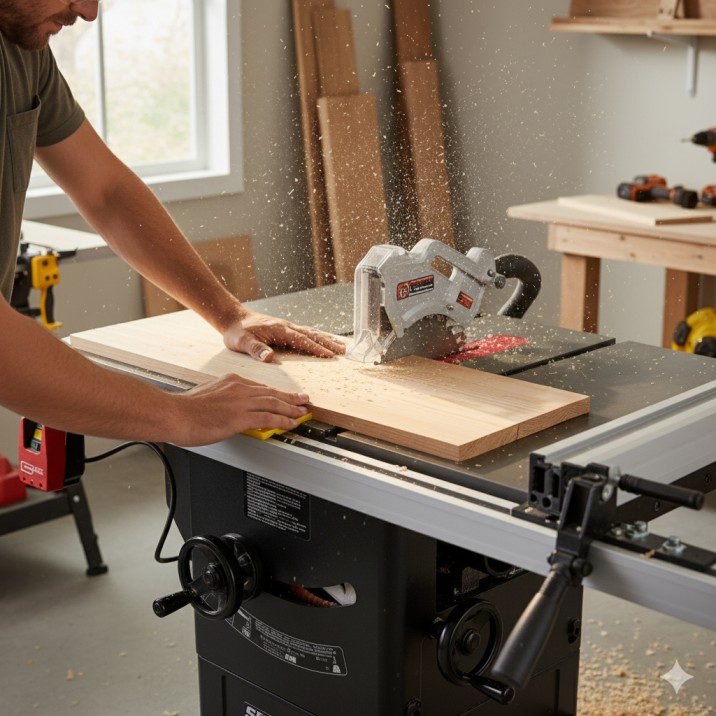
After cutting through the marketing claims, here’s what actually happens when you put wood to blade.
Everyday Cutting Tasks
For standard ripping and crosscutting operations with dimensional lumber, the Maksiwa performs admirably. Cutting 2x4s, 2x6s, and similar construction-grade softwoods is smooth and predictable. The motor has enough power to maintain blade speed through these materials without significant slowdown.
Hardwoods like oak, maple, and walnut require a bit more patience. The saw will absolutely cut through them, but feed rate matters more here than with softer woods. Push stock through too aggressively, and you’ll hear the motor strain. Maintain a steady, moderate pace, and you’ll get clean cuts without burning or excessive blade deflection.
Sheet goods are where size becomes a factor. The table surface provides adequate support, but wrangling a full 4×8 sheet of plywood solo is challenging on any portable or contractor-style saw. You’ll want infeed and outfeed support—sawhorses with clamped boards work perfectly fine and don’t require buying expensive extension tables.
Cut Quality and Accuracy
Blade quality plays a massive role here, and this is where I need to be blunt: the blade that comes with the Maksiwa is serviceable for rough carpentry but inadequate for fine woodworking. It’s a combo blade with probably 24-40 teeth, depending on the model year.
Upgrading to a quality 50-60 tooth blade designed for smooth crosscuts and a dedicated 24-tooth rip blade will transform your results. We’re talking about the difference between visible tear-out that requires heavy sanding versus clean edges that need minimal cleanup. This isn’t unique to Maksiwa—virtually all budget saws ship with mediocre blades—but it’s worth factoring an extra $50-80 into your budget for proper blades.
With a decent blade installed and the fence properly squared, the Maksiwa can hold tolerances within 1/16 inch on most cuts, which is perfectly acceptable for furniture and cabinet work. If you need tighter tolerances, you’ll be doing final dimensioning with hand planes or a jointer anyway.
Dust Collection: Don’t Get Your Hopes Up
Let’s address the elephant in the workshop: dust collection on this saw is barely adequate at best. There’s a dust port located at the lower cabinet that connects to standard shop vacuum or dust collector hoses, but it captures maybe 60-70% of the sawdust on a good day.
The blade guard includes a dust shroud that helps a bit, but you’ll still have fine dust escaping around the blade opening and miter slots. If you’re sensitive to dust or working in an enclosed space, plan on wearing a quality respirator and running an overhead air filtration system alongside the built-in dust port.
Safety Features: What Protections Are Built In?
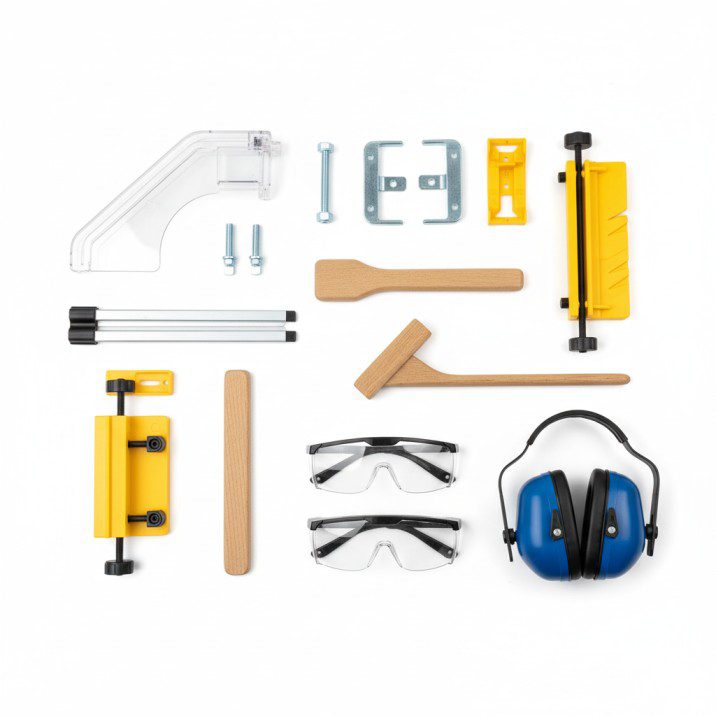
Safety should never be an afterthought, especially with table saws, which remain one of the most dangerous tools in any workshop. The Maksiwa includes several standard safety features, though it’s worth understanding exactly what protection you’re getting.
The saw comes with a blade guard assembly that includes a clear plastic cover, anti-kickback pawls, and a riving knife or splitter (depending on the model). Using these safety devices is non-negotiable for through-cuts where they don’t interfere with the operation. Yes, they’re sometimes inconvenient to remove for dado cuts or non-through cuts, but your fingers are worth the extra minute of setup time.
There’s a prominent on/off switch with a large paddle that’s easy to hit with your knee or hip in an emergency. Some models include a magnetic switch that prevents accidental startups after power interruptions—a genuinely useful feature that’s worth having.
What the Maksiwa doesn’t include is flesh-sensing technology like SawStop’s patented system. Those saws cost three to five times more, and while the safety feature is incredible, it’s simply not realistic at this price point. Instead, you need to rely on proper technique, push sticks, featherboards, and maintaining constant awareness of where your hands are relative to the blade.
Who Should Actually Buy This Saw?
The Maksiwa table saw occupies a specific niche, and understanding whether you fit that profile will determine your satisfaction with the purchase.
This saw makes sense if you’re a hobbyist woodworker building occasional furniture pieces, doing home improvement projects, or exploring woodworking without committing thousands of dollars upfront. It’s ideal for someone who has a dedicated workshop space (even if it’s just a single-car garage) and needs a stationary saw for regular use.
It’s also appropriate for DIYers who have graduated beyond circular saws and are ready for more precise, repeatable cuts but aren’t yet at a skill level or project volume that justifies a $1,500-plus contractor saw or hybrid model.
However, this saw isn’t the right choice if you’re running a professional woodworking business where downtime costs you money, if you’re regularly working with thick hardwoods or specialty materials, or if you need the absolute highest level of precision for specialized joinery work.
Maintenance and Long-Term Ownership Considerations
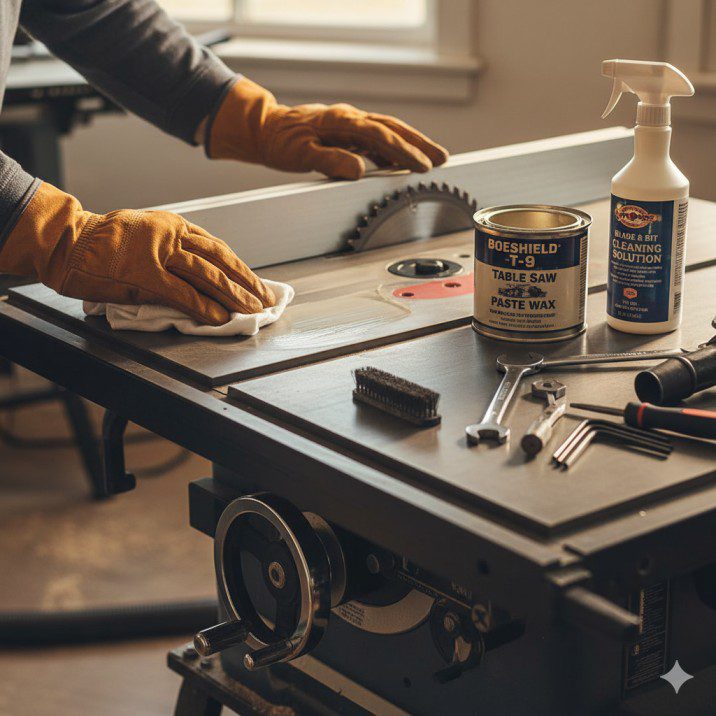
Any power tool requires maintenance, and the Maksiwa is no exception. The good news is that routine care is straightforward and doesn’t require specialized knowledge.
Keep the table surface clean and occasionally apply a coat of paste wax to reduce friction and prevent rust. The miter slots and adjustment mechanisms benefit from periodic cleaning and light lubrication—just don’t overdo it with oil, which attracts sawdust and creates a gummy mess.
Check belt tension occasionally if your model uses a belt-driven system. A loose belt causes power loss and can lead to inconsistent blade speed. Most models allow for relatively easy belt access through a panel on the cabinet.
Blade maintenance is crucial. Keep your blades clean using specialized blade cleaner or a degreaser to remove pitch and resin buildup. Dull blades force the motor to work harder and produce poor cut quality. Depending on usage, expect to sharpen or replace blades several times per year.
Alternative Options Worth Considering
Before pulling the trigger, it’s worth looking at what else exists in the similar price range. Models from brands like Craftsman, Skil, and various import brands occupy the same market segment. Each has trade-offs in terms of features, build quality, and customer support.
If you can stretch your budget slightly higher, the entry-level models from DeWalt or Bosch offer improved build quality and better customer service networks, though you’ll pay a premium for the established brand name. On the flip side, you can find even cheaper options, but they typically involve significant compromises in fence quality, motor power, or overall stability.
The Verdict: Making Your Decision
So, should you buy the Maksiwa table saw in 2025? The answer, as with most tool purchases, depends on your specific situation.
This saw delivers solid value for hobbyist woodworkers who understand its limitations and set realistic expectations. It’s not a professional-grade machine that will run flawlessly for decades with minimal maintenance, nor is it precision equipment suitable for ultra-fine tolerance work. What it is, however, is a capable saw that can handle the vast majority of home workshop tasks at a price point that won’t require financing.
The key to satisfaction is going in with eyes open: plan to spend time on proper setup, budget for blade upgrades, understand that you’ll occasionally need to re-square the fence, and accept that some features won’t match premium models. If you can live with those realities, the Maksiwa represents a reasonable entry point into stationary table saw ownership.
For someone building their first real workshop, this saw can serve you well for years before you either outgrow it or decide woodworking isn’t your long-term passion. And honestly, that’s exactly what a tool in this category should do—provide a solid foundation for skill development without requiring a massive upfront investment.
Just remember: no table saw will compensate for poor technique or inattention. Take the time to learn proper safety procedures, use push sticks religiously, and never rush through cuts. The best saw in the world is the one that helps you create projects safely and enjoyably, whatever brand name happens to be stamped on the label.

Finlay Connolly is a woodworking enthusiast and power tool specialist with over a decade of hands-on experience in the workshop. As the founder and lead writer at ProTableSawReviews.com, Finlay combines expert knowledge with real-world testing to help woodworkers, DIYers, and professionals choose the best tools for the job. With a sharp eye for detail and a passion for precision, Finlay is committed to providing trustworthy, practical advice backed by years of experience and research in the field. Whether you’re cutting dados or comparing fence systems, you can count on Finlay for honest, reliable reviews that make your next cut your best one.
